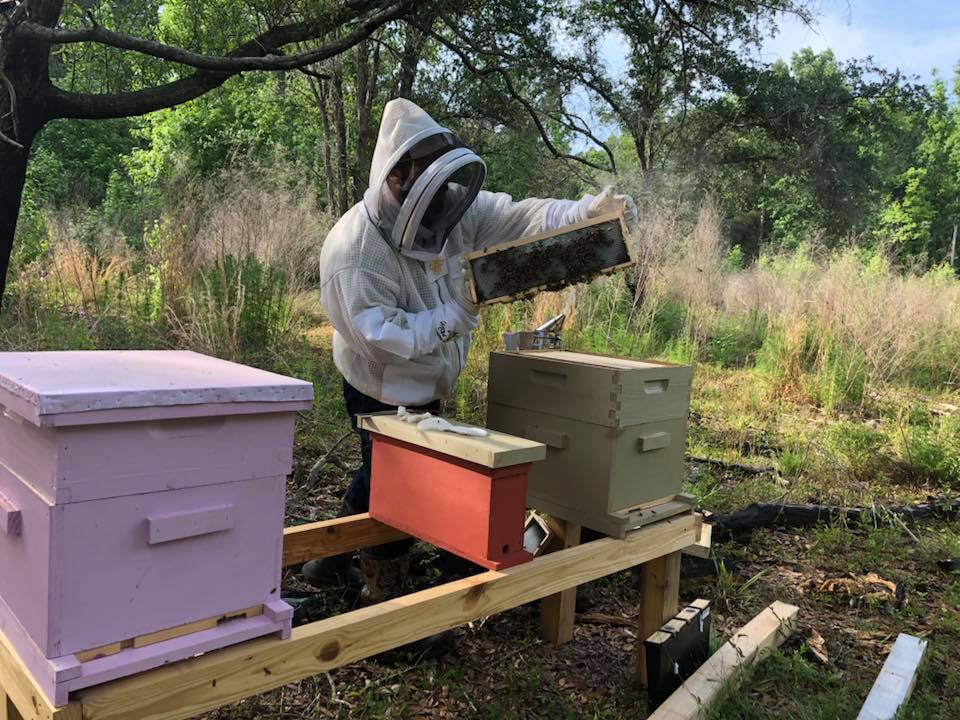Apart from securing a beehive, there is an array of tools beekeepers use throughout the season. As experienced beekeepers, we’ve compiled the most essential beekeeping supplies for beginner beekeepers, ultimate hobbyists, and seasoned professionals. Much of the beekeeping equipment preferences vary from person to person, but over time, beekeepers learn what works best for their hive and comfort level.
Protective Beekeeping Clothing
One of the most important pieces of beekeeping equipment is the clothing you need to protect yourself and the bees. We do not recommend using previously owned beekeeping supplies, especially used clothing like veils, suits, or gloves.
Quality Bee Suits
With a wide variety of bee suits on the market, many of them are too hot or cumbersome. Superior beekeeping suits often have metal zippers, heavy-duty elastic bands, and breathable mesh. As experienced beekeepers, we’ve developed our original 3-layer mesh material to ensure you remain cool and protected.
Replacing your bee suit every 3-4 years is ideal, but depending on the elements and conditions your suit endures, it could extend the lifespan. Over time, the venom from bee stings can degrade the quality of your beekeeping clothing. Investigating the fabric types and hardware on the suit will help you avoid having to repurchase suits on a more frequent basis.
Veils & Gloves
Easy-Access Veils
Easy access veils are intended to provide the most protection while having the ability to quickly unzip the veil to wipe your face, take a sip of water, or taste some honey while limiting sting exposure time. With a design that allows additional space between the mesh and face, this creates a comfortable forward-leaning fit for checking your hives. Our veils are securely attached to our suits and jackets using a metal YKK zipper, allowing for easy removal and interchangeability across all Guardian Bee Apparel suits and jackets.
Round Veils
Our round veils are domed-shaped and offer 360-degree visibility. This type of veil fits a wide variety of head sizes and is the most common design on the market. Guardian Bee has created a round veil with zippers on the front left and right sides so beekeepers can freely open the veil to clear their eyes or stay hydrated, while being mindful of potential bee stings.
Pro-Fit Veils
Our Pro-Fit veils are designed to allow quick access to your face without removing your entire veil. This type of beekeeping veil makes it easier to wipe sweat, itch your face, or take a sip of water while tending to your bees. This style also allows for safe honey tastings due to the conveniently placed zippers, which help lower the beekeeper’s risk of getting stung.
Gloves
For the most durable beekeeping gloves, choosing a leather option is preferred. Whether you prefer a short or long, Beekeepers need strong yet flexible gloves for maneuvering tools and operating equipment in the field. Guardian Bee’s high-quality beekeeping gloves are created from durable leather but are soft enough to avoid skin irritation.
Beehive Tools & Equipment
In addition to protective clothing, beekeepers must properly prepare and choose the right equipment for their hive. This depends on climate conditions, the types of hives, and personal preferences.
Hive Stands
Hive stands serve the function of elevating the bees above the ground. Reasons for raising the hive include keeping your bees away from unwanted pests, regulating airflow, and avoiding moisture build-up. They also prevent rainwater from collecting to ensure a dry, healthy hive. The stand should be at an accessible height for the beekeeper to service the hive comfortably.
Hive stands can come in so many different materials including, but not limited to:
- Wood
- Metal
- Plastic
- Brick
- DIY Options
Durability is a major component in choosing the hive stand material. The material needs to be structurally sound to hold the beehive when it’s filled with honey. Accounting for the additional weight will help your bees thrive in their new home.
Hive Tools
Beekeepers use many tools to maintain healthy hives. The J-hook tool is one of the most important in beekeeping because of its resourcefulness and is considered an all-in-one hive tool by some beekeepers.
J-hooks have a narrow blade on one end and a hooked end on the other. The flat side is used for prying the hive bodies and supers, while the hooked end is used to separate the bee frame from the hive.
J-hook tools can also assist in scraping excess wax, cleaning burr comb, and removing nails. These hive tools are made from extremely durable materials like stainless steel.
Smokers
Smokers are used to calm the bees when inspections take place. They are commonly used with wood, cotton, or burlap to produce smoke. It’s important to note that while smoke has a calming effect, beekeepers use it in moderation.
Excessive smoke can stress the bees, potentially leading to negative consequences for the hive. The goal is to create just enough smoke to initiate the observed calming responses without causing harm or compromising the integrity of the hive.
Bee Brushes
Bee brushes are for gently moving bees from the frame so beekeepers can investigate the health of the hive. This is an important tool for beekeepers, as it needs to be crafted to move while keeping the bees safe.
Honey Extraction & Bottling Supplies
Honey Extractors
Honey extractors spin the filled frames until all the honey drops into a container. These machines can be costly, so many beekeepers have found other creative ways to extract the honey from frames. Additionally, local beekeeping clubs and groups sometimes offer a collective extractor for members.
Bottling Bucket & Sieve
Bottling buckets are used to collect the honey once the extractor has removed it from the frame. Most buckets come with a honey gate or nozzle that allows beekeepers to regulate how much honey flows into the container.
Sieves help filter out the impurities found in honey, which include solid particles that come from the comb once the honey is extracted. The point of the sieve is to ensure the honey meets quality standards and looks visually appealing.
Glass or Plastic Containers
Beekeepers may choose plastic or glass containers depending on desired presentation, cost, transportation considerations, and environmental concerns. Ultimately, both glass and plastic containers can effectively serve the purpose of storing and presenting honey to consumers.
Seasonal Beekeeping Supplies
Bee supplies can vary as temperatures fluctuate throughout the year. Consider the weather when caring for your bees. This important detail matters greatly in the health and survival of your hive and honey production.
Cold Seasons
Remember, bees are ectothermic. This means they cannot create their own heat and depend on the environment around them for warmth. Dropping temperatures make it impossible for bees to maintain the same metabolic processes they need to survive.
Metabolic rates are what keep the bees’ bodily functions and energy production thriving at normal levels. Reduction in temperatures can render the bees unable to move if prolonged low temperatures persist. If it’s too cold, consider using a quilt box or hive wraps to contain heat within the hive.
Hot Seasons
Just like cold weather, extremely hot weather can lower the bee’s metabolic rates. Bees are able to experience stress from elevated temperatures, which can lead to a decreased lifespan. Bees are known for using nearby water to cool the hive.
If it becomes too hot, providing accessible water sources and ventilation is important in maintaining the hive’s health. Additionally, there are shade cloths specifically made for beekeepers to shield the hive from harsh sun rays.

